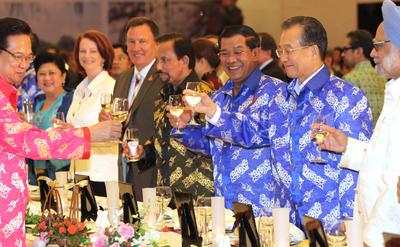Asia is unlikely to see the institutionalisation or pooling of sovereignty that occurred earlier in Europe as the region lacks the same incentives for doing so. Tariffs on goods are now relatively low as governments have reduced barriers through spontaneous unilateral liberalisation and sensitivities remain to pooling sovereignty necessary for deeper integration — even within ASEAN, the default leader. The China–ASEAN FTA, however, created incentives for other large economies to counter potential discrimination with similar deals of their own.
The future of economic cooperation is complicated. The recent global crisis revealed the vulnerabilities of continued reliance on export-led growth strategies and created, at least for a time, incentives to rebalance growth in economies throughout the region to rely more on domestic and regional demand. Reforms of previously protected service sectors will be needed, implying more emphasis in future trade agreements on competition policies, investment performance measures, technical barriers to trade etc. The Trans Pacific Partnership (TPP) might create further incentives in this direction but those negotiations are becoming quite complicated. The negotiating frameworks agreed by the November 2011 might provide a clearer basis for evaluating what liberalisation the TPP will be able to achieve.
If services and investment liberalisation proceed unilaterally, as was the case in goods, there is the danger pointed out by Richard Baldwin that writing rules to eliminate behind the border barriers will reflect power asymmetries (such as between the United States, European Union and Japan and smaller economies with which they have agreements) which could undermine universally accepted WTO trade. At the same time, China, India and Brazil are large enough to ignore such agreements — for now. When they reach the levels of development where their multinationals produce more abroad, the rules will have been written and they will be rule-takers, which could further undermine the WTO’s future legitimacy.
With no clear leadership in prospect ASEAN will continue to fill this role. The 2007 commitment to achieve an economic community by 2015 is visionary and ambitious; but the deep integration needed for a single market with goods, services, capital, investment and skilled labour flowing freely seems unlikely by that date. Even so, ASEAN is developing a framework for macroeconomic cooperation within which the ASEAN +3 are beginning to gain traction.
The record suggests sequenced integration in Asia. Thus the current level of institutionalisation will see more consultation, greater transparency; more formalised arrangements and efforts to prevent policy reversals and crises but they will not pool sovereignty.
More likely are efforts to better use scarce leadership resources in the continuing variable geometry in which the broadest membership meets (as is the case in the Asian Economic Summit) to discuss strategic issues. With time and experience it might also engage in setting and monitoring goals and targets if such were adopted, similar to the G20’s emerging role at the global level. To prevent crises, ASEAN +3 institutions would focus on surveillance and analysis among the systemically significant economies — with the view that as members gain more confidence in the process and in each other, the forum would be used for bargaining and closer policy coordination. Crises will require managers, however, and are likely to evoke a steering committee of the largest economies. Will ASEAN remain at the core?
Asia’s rising weight in the world economy brings with it external expectations about its role in shaping the future world order. Will the region continue to cede the leadership of the world trading system to the United States and Europe, as it has through much of the post-war period? Or will it use its increasing economic weight to shape the world order by, say, helping to conclude the Doha Round or building a Pacific-wide free trade area? In macroeconomic surveillance and cooperation the precedent has been set for close CMIM–IMF cooperation and Europe’s recent experience with the European Financial Stability Facility (EFSF) has underlined the necessity, but that precedent has not yet been formalised.
Yet Asia’s growing economic weight and its strong interdependence with the rest of the world economy suggest that purely regional institutions are unlikely to accommodate its long term interests. A very positive outcome of this dilemma would be Asian leaders and institutions emerging as champions of a stable and open global economic system in both word and deed.
This is an excerpt from a paper delivered to the Roundtable on Asia, the G20 and global regional architecture at the EABER/SABER conference at the Australian National University, Canberra, 17 August 2011.
Dr Wendy Dobson is co-director of the Institute for International Business in the University of Toronto’s Rotman School of Management and former Associate Deputy Minister of Finance in the Canadian government.
This article appeared in the most recent edition of the East Asia Forum Quarterly, ‘Asia’s global impact‘.

